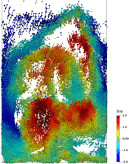Recently, Dr Kun Luo and his colleagues studied the biomass gasification in a bubbling fluidized bed (BFB) reactor numerically based on a particle-scale computational fluid dynamics-discrete element method (CFD-DEM), featuring thermochemical and polydispersity effects.
After model validation, the particle-scale information (e.g., particle motions, particle mixing, solid dispersion, and heat transfer contribution) are thoroughly explored with the discussion of the effects of several critical operating parameters on particle behaviours. The results demonstrated that the middle dense region has the highest biomass pyrolysis reaction rate due to the vigorous particle motion. Sand and biomass particles show synchronous horizontal motions, and the solid vertical dispersion coefficients are much higher than the solid horizontal ones, denoting that the vertically introduced gas flow dominates bed hydrodynamics. A higher operating temperature causes a higher solid dispersion coefficient. Elevating temperature and steam to biomass ratio (S/B) first increases and then decreases the particle mixing index. Convection plays a dominant role during the biomass gasification process, followed by the radiation and heat of reaction.

Based on the above, Luo's team concluded that the conduction accounts for the smallest proportion and can be neglected. Increasing operating temperature promotes chemical reactions, biomass temperature, and all heat transfer modes. Increasing S/B promotes biomass motions and gasification reactions, leading to more heat consumed and biomass temperature decrease. Decreasing biomass temperature results in a larger temperature difference between biomass particles and bed material, which enhances the conduction, convection, and radiation.
The work was published in Chemical Engineering Journal, and could be accessed at Particle behaviours of biomass gasification in a bubbling fluidized bed - ScienceDirect.
About Professor Luo
Kun Luo is a professor at Zhejiang University. He is a Distinguished Young Scholar, and is a member of the board of the Chinese Society of Engineering Thermophysics, and Deputy Secretary General of the Process Simulation and Simulation Committee of the Chinese Chemical Society.
For many years, he has been engaged in theoretical modeling and numerical simulation of complex multi-scale coupled problems in power and environmental engineering, including computational multiphase flow, computational combustion, multi-scale simulation of wind energy utilization, and multi-scale modeling of air quality in atmospheric pollution areas. He proposed a new method for direct numerical simulation of complex large-scale multiphase turbulent combustion processes, discovered new phenomena and mechanisms of coupling multiphase turbulent combustion processes at the interface, developed a new model for more accurate engineering calculations, and successfully applied it to engineering practice, which brought obvious economic and environmental benefits. As a project leader and research manager, he has conducted more than ten national/provincial research projects and published more than 200 papers in scholarly journals.
About SIAS
Shanghai Institute for Advanced Study of Zhejiang University (SIAS) is a jointly launched new institution of research and development by Shanghai Municipal Government and Zhejiang University in June, 2020. The platform represents an intersection of technology and economic development, serving as a market leading trail blazer to cultivate a novel community for innovation amongst enterprises.
SIAS is seeking top talents working on the frontiers of computational sciences who can envision and actualize a research program that will bring out new solutions to areas include, but not limited to, Artificial Intelligence, Computational Biology, Computational Engineering and Fintech.

